
Tanacetum is a genus of about 160 species of flowering plants in the aster family, Asteraceae, native to many regions of the Northern Hemisphere. They are known commonly as tansies. The name tansy can refer specifically to Tanacetum vulgare, which may be called the common tansy or garden tansy for clarity. The generic name Tanacetum means 'immortality' in Botanical Latin, since tansy was once placed between the burial sheets of the dead to repel vermin.
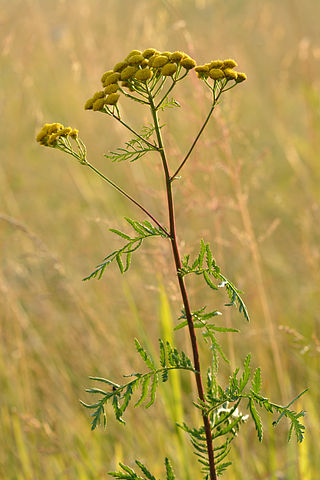
Tansy is a perennial, herbaceous flowering plant in the genus Tanacetum in the aster family, native to temperate Europe and Asia. It has been introduced to other parts of the world, including North America, and in some areas has become invasive. It is also known as common tansy, bitter buttons, cow bitter, or golden buttons. The Latin word vulgare means "common".

Cirsium rhothophilum is a rare North American species of thistle known by the common name surf thistle. It is endemic to California, where it is known only from the coastline around the border between San Luis Obispo and Santa Barbara Counties. It grows in sand dunes and coastal scrub near the beach.
Crepis pleurocarpa is a North American species of flowering plant in the family Asteraceae known by the common name nakedstem hawksbeard. It is native to the western United States (Washington, Oregon, northern California and western Nevada.
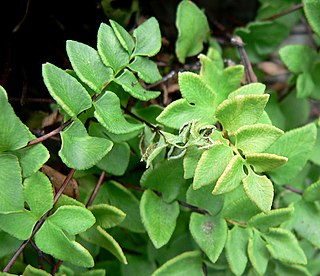
Pellaea breweri is a species of fern known by the common name Brewer's cliffbrake. It is native to much of the Western United States. It grows in rocky habitat such as cliffs and mountain slopes.
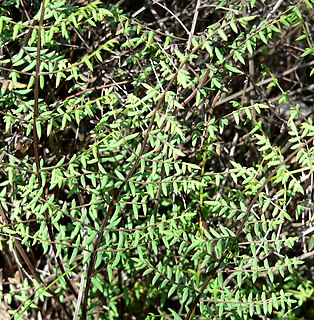
Pellaea mucronata is a species of fern known by the common name bird's foot cliffbrake.
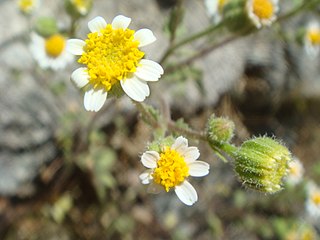
Perityle emoryi is a species of flowering plant in the aster family known by the common name Emory's rockdaisy. It is native to the Southwestern United States, northwest Mexico, and the Baja California Peninsula. It is a common wildflower of the deserts, and can also be found in California coastal regions.
Pseudobahia peirsonii is a rare species of flowering plant in the family Asteraceae known by the common names San Joaquin adobe sunburst and Tulare pseudobahia. It is endemic to California, where it is known from a few mostly small occurrences along the southeastern side of the San Joaquin Valley where it rises into the Sierra Nevada foothills. It grows in grassland and oak woodland habitat. It prefers heavy adobe clay soils. The plant became a federally listed threatened of the United States in 1997.
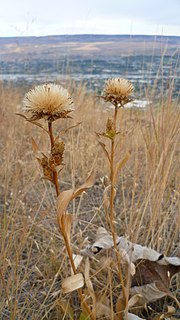
Pyrrocoma carthamoides is a species of flowering plant in the family Asteraceae known by the common name largeflower goldenweed. It is native to western North America from British Columbia to northeastern California to Wyoming, where it is known from grassland, woodlands, forests, barren areas, and other habitat. It is a perennial herb growing from a taproot and producing one or more stems to about half a meter in maximum length, the stems reddish-green and leafy. The largest leaves are at the base of the stem, measuring up to 20 centimeters long, lance-shaped with spiny sawtoothed edges. Leaves higher on the stem are smaller and hairier. The inflorescence is a single flower head or a cluster of up to four. Each bell-shaped head is lined with phyllaries each up to 2 centimeters long. It has many yellow disc florets surrounded by a fringe of yellow ray florets up to 7 millimeters long; ray florets are occasionally absent. The fruit is an achene which may be well over a centimeter in length including its pappus.

Pyrrocoma lucida is a species of flowering plant in the family Asteraceae known by the common names sticky goldenweed and sticky pyrrocoma. It is endemic to California, where it is known only from the northern Sierra Nevada. It grows in mountain forests and clay flats with alkali soils. This is a perennial herb growing from a taproot, producing an erect stem up to 75 centimetres (30 in) tall. It is hairless and glandular, its surface resinous and shiny. The leaves are lance-shaped with sharply toothed edges, the largest near the base of the stem reaching 25 centimetres (10 in) in length. Smaller leaves up to 10 centimetres (4 in) long occur higher on the stem. The inflorescence is a narrow spikelike array of many flower heads lined with thick, overlapping, gland-dotted phyllaries. Each head contains up to 40 yellow disc florets surrounded by a fringe of up to 20 yellow ray florets. The fruit is an achene up to a centimeter long including its pappus.

Rudbeckia californica is a species of flowering plant in the family Asteraceae, known by the common name California coneflower.

Rudbeckia occidentalis is a species of flowering plant in the family Asteraceae known by the common name western coneflower. It is native to the northwestern United States from Washington to northern California and east to Wyoming and Montana, where it grows in moist habitat types, such as meadows. It is an erect perennial herb growing from a thick rhizome, its mostly unbranched stem approaching two meters in maximum height. The large leaves are generally oval but pointed, and lightly to deeply toothed along the edges, growing to 30 centimeters long. The inflorescence is one or more flower heads with purplish bases up to 6 centimeters wide. There are no ray florets, just an array of reflexed phyllaries around the purple-brown center packed with disc florets. This center, containing the receptacles, lengthens to several centimeters in length as the fruits develop. The fruits are achenes each a few millimeters long, some tipped with pappi of tiny scales.
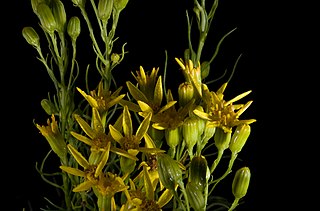
Senecio blochmaniae is an uncommon species of flowering plant in the aster family known by the common names dune ragwort and Blochman's ragwort. It is endemic to the Central Coast of California, where it is known only from the direct coastline of San Luis Obispo and Santa Barbara Counties. It grows in sand dunes and sandy areas on coastal floodplains. It is a subshrub producing several arching stems often well exceeding a meter tall from a thick taproot. The stems are covered in many leaves, which are linear in shape, thick, and measure up to 12 centimeters long. The lower leaves become dry and curl up. The flower heads are lined by about 13 green-tipped phyllaries. They contain many yellow disc florets and each has usually 8 narrow yellow ray florets about a centimeter long.
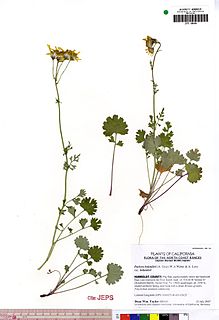
Packera bolanderi is a species of flowering plant in the aster family known by the common names Bolander's ragwort and seacoast ragwort. It is native to the west coast of the United States from Washington to northern California, where it grows in wet coastal forests and woodlands. There are two varieties of the species which differ slightly in morphology and habitat occupied; these varieties have been considered separate species by some authors. The var. bolanderi has thicker leaves, occurs farther south, and occupies more open types of habitat, than does var. harfordii. This plant in general is a perennial herb producing one to three stems up to half a meter tall. The basal leaves have blades up to 12 centimeters long which are divided into several lobes and borne on long, thin petioles. Leaves growing farther up the stem are smaller and have more lobes on their blades. The inflorescence contains several flower heads, each lined with dark green phyllaries. The head contains many golden yellow disc florets and generally either 8 or 13 yellow ray florets each over a centimeter long. The fruit is an achene tipped with a pappus of bristles.

Packera breweri is a species of flowering plant in the aster family known by the common name Brewer's ragwort. It is endemic to central California, where it occurs in the woodlands and grasslands of the Central Coast Ranges. They are more frequently found in mid-southern counties of California near the coast, such as Kern or Monterey.

Packera cana is a species of flowering plant in the aster family known by the common name woolly groundsel. It is native to western and central North America, where it can be found in a wide array of habitat types at all elevations from grassland to the alpine climates of mountain peaks.
Packera clevelandii is an uncommon species of flowering plant in the aster family known by the common name Cleveland's ragwort. It is endemic to California, where it is known from only two small regions, a section of the North Coast Ranges around Napa County and a part of the Sierra Nevada foothills on the opposite side of the Sacramento Valley. The plant grows in shrubby chaparral, often on serpentine soils.
Packera ganderi is a rare species of flowering plant in the aster family known by the common name Gander's ragwort. It is endemic to southern California, where it is known from a few occurrences in San Diego and Riverside Counties.
Stephanomeria parryi is a species of flowering plant in the family Asteraceae known by the common name Parry's wirelettuce. It is native to the southwestern United States, where it grows in many types of habitat, including many desert areas. It is a perennial herb growing from a thick root and producing one or more slender, upright stems up to about 40 centimeters tall. The green leaves are linear to lance-shaped with lobed edges and are up to 8 centimeters long near the base of the plant. Flower heads occur on the spreading branches. Each has up to 13 or 14 ray florets, each with an elongated tube and a whitish ligule up to 1.5 centimeters long. The fruit is an achene tipped with a spreading cluster of long, tan, plumelike pappus bristles.

Tanacetum huronense, also known as Lake Huron tansy, is a type of wildflower most commonly found on sand dunes around the Great Lakes. Lake Huron tansy currently requires conservation measures in some regions.















